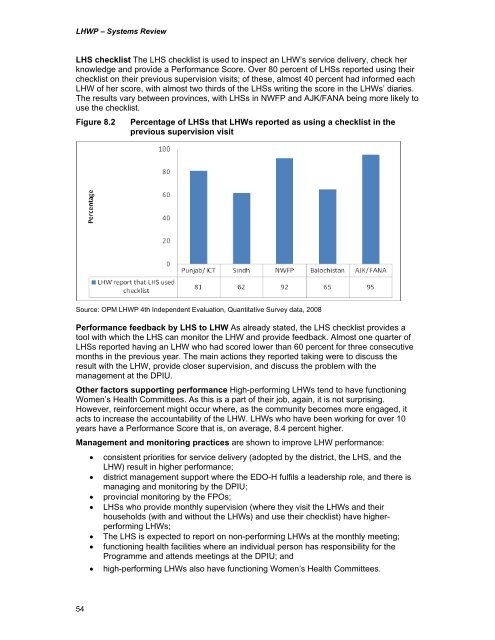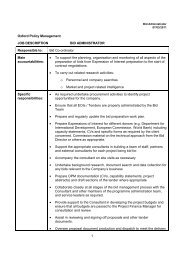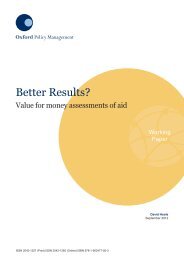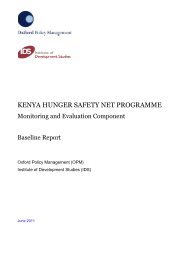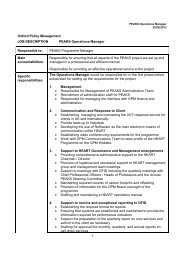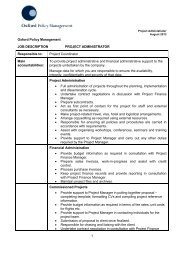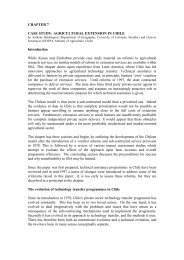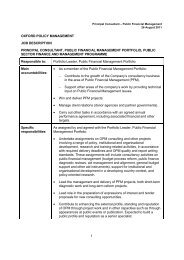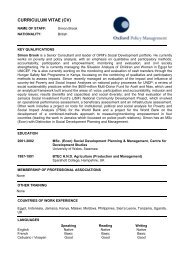LHW Systems Review - Oxford Policy Management
LHW Systems Review - Oxford Policy Management
LHW Systems Review - Oxford Policy Management
Create successful ePaper yourself
Turn your PDF publications into a flip-book with our unique Google optimized e-Paper software.
<strong>LHW</strong>P – <strong>Systems</strong> <strong>Review</strong>LHS checklist The LHS checklist is used to inspect an <strong>LHW</strong>’s service delivery, check herknowledge and provide a Performance Score. Over 80 percent of LHSs reported using theirchecklist on their previous supervision visits; of these, almost 40 percent had informed each<strong>LHW</strong> of her score, with almost two thirds of the LHSs writing the score in the <strong>LHW</strong>s’ diaries.The results vary between provinces, with LHSs in NWFP and AJK/FANA being more likely touse the checklist.Figure 8.2Percentage of LHSs that <strong>LHW</strong>s reported as using a checklist in theprevious supervision visitSource: OPM <strong>LHW</strong>P 4th Independent Evaluation, Quantitative Survey data, 2008Performance feedback by LHS to <strong>LHW</strong> As already stated, the LHS checklist provides atool with which the LHS can monitor the <strong>LHW</strong> and provide feedback. Almost one quarter ofLHSs reported having an <strong>LHW</strong> who had scored lower than 60 percent for three consecutivemonths in the previous year. The main actions they reported taking were to discuss theresult with the <strong>LHW</strong>, provide closer supervision, and discuss the problem with themanagement at the DPIU.Other factors supporting performance High-performing <strong>LHW</strong>s tend to have functioningWomen’s Health Committees. As this is a part of their job, again, it is not surprising.However, reinforcement might occur where, as the community becomes more engaged, itacts to increase the accountability of the <strong>LHW</strong>. <strong>LHW</strong>s who have been working for over 10years have a Performance Score that is, on average, 8.4 percent higher.<strong>Management</strong> and monitoring practices are shown to improve <strong>LHW</strong> performance:• consistent priorities for service delivery (adopted by the district, the LHS, and the<strong>LHW</strong>) result in higher performance;• district management support where the EDO-H fulfils a leadership role, and there ismanaging and monitoring by the DPIU;• provincial monitoring by the FPOs;• LHSs who provide monthly supervision (where they visit the <strong>LHW</strong>s and theirhouseholds (with and without the <strong>LHW</strong>s) and use their checklist) have higherperforming<strong>LHW</strong>s;• The LHS is expected to report on non-performing <strong>LHW</strong>s at the monthly meeting;• functioning health facilities where an individual person has responsibility for theProgramme and attends meetings at the DPIU; and• high-performing <strong>LHW</strong>s also have functioning Women’s Health Committees.54


